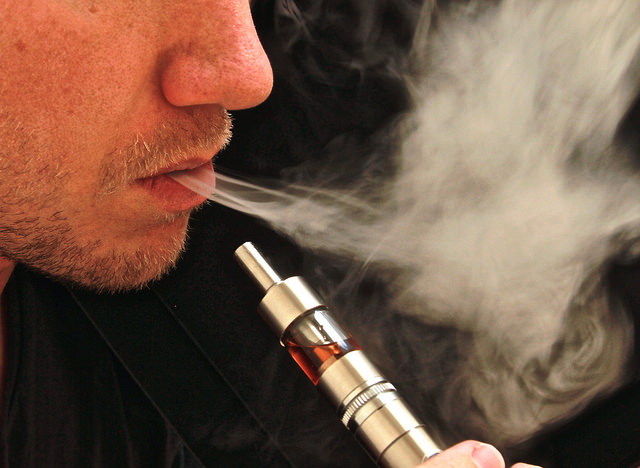E-cigarettes have always been marketed as a safer alternative to traditional cigarettes smoking. Even though their vapors do not contain all the byproducts of tobacco combustion that are often associated with cancer, today a new clinical study raised several concerns about their actual safety. An independent review from the Center for Environmental Health (CEH) has in fact thoroughly investigated the gasses produced by the famous tool invented in 2003 by the Chinese pharmacist Hon Lik.

Although e-cig’s effectiveness in helping people quit smoking has always been questioned, this new technological marvel rapidly expanded its market in both Europe and the US since its debut in 2007. Yearly revenues just in the US have been estimated to be around $3.5 billion, with a potential expansion for up to $10 billion in just two years.
The Food and Drug Administration (FDA) never approved the use of this device, though, as no extensive or large enough trial on e-cig has ever thoroughly investigated their effects on human health. Several controversies were raised against FDA decisions, though, as many complained that the Tobacco Advisory Panel committees of the American agency were under several conflicts of interests (1, 2). The lack of a proper regulation on e-cigs led people to perceive them as safe, which can be somewhat concerning especially given the high number of youths that regularly use these devices. The Center for Disease Control and Prevention (CDC) recently reported that e-cigarette use among middle and high school students tripled from 2013 to 2014 (3).
Are electronic cigarettes dangerous for health?

The new CEH study, titled “A Smoking Gun: Cancer-Causing Agents in E-cigarettes”, for the first time tested 97 vaping products from 24 different e-cigarette manufacturers, looking for any kind of cancer-causing agent. The point of the study is to investigate the differences between the various devices (4). Previous studies showed that chemicals produced by e-cigarettes often vary widely from a model to another, including several discrepancies between the nicotine levels listed on the label and those actually generated by the device (5).
The results of the study leave no space for doubts: 90% of the companies had, at least, one device that produced harmful cancer-inducing gasses. One tested device produced 254 times the legal amount of acetaldehyde while another one produced 473 times the amount of formaldehyde deemed to be safe by actual regulations (California’s consumer protection law, Proposition 65). The two byproducts were present in alarmingly hazardous levels also in products that were marketed as nicotine-free (4).
A previous New England Journal of Medicine study from January 2015 already showed that ecig’s vapors contained hazardous levels of hidden formaldehyde (6). However, a substantial controversy was raised claiming that the temperatures used for testing were much higher than actual ones reached by these devices. This new CEH study used specific smoking machines provided by the American Association for Laboratory Accreditation (A2LA), an independent non-profit, non-government organization that tests conventional cigarettes. Their machines simulate the exact smoking routine and proved to be as realistic as they can be in several other previous tobacco cigarette testings.
Although e-cigarettes can still be an important cancer-free alternative to conventional smoking, it’s clear that manufacturers need to ensure that safer products are built. Also properly informing consumers about the risk of exposure to cancer-inducing agents is mandatory. Researchers from the CEH plan to file a lawsuit against e-cigarette companies, blaming them for deceptive advertising and promulgating unverified safety claims. They aim not to shut down the e-cigarette industry, but to force manufacturers to improve their safety policies and “influence the e-cigarette industry to change its practices that mislead users.”
Article written by Dr. Claudio Butticè, PharmD.
REFERENCES
- 1. Tobacco Today. “It’s Official: Big Pharma is Lobbying Against Electronic Cigarettes.” Dr. Michael Siegel. June 16th, 2014. http://www.tobaccotoday.info/2014/06/16/its-official-big-pharma-is-lobbying-against-electronic-cigarettes-dr-michael-siegel/ (Accessed September 2015)
- 2. Tobacco Truth. “Conflicts of Interest Exposed, FDA Reorganizes Tobacco Advisory Panel.” Brad Rodu. March 5, 2015 http://rodutobaccotruth.blogspot.it/2015/03/conflicts-of-interest-exposed-fda.html (Accessed September 2015)
- 3. Center for Disease control and Prevention. “E-cigarette use triples among middle and high school students in just one year”. http://www.cdc.gov/media/releases/2015/p0416-e-cigarette-use.html (Accessed September 2015)
- 4. Center for Environmental Health. “A Smoking Gun. Cancer-causing chemicals in e-cigarettes” http://www.ceh.org/wp-content/uploads/CEH-2015-report_A-Smoking-Gun_-Cancer-Causing-Chemicals-in-E-Cigarettes.pdf (Accessed September 2015)
- 5. S-H Zhu et al. 2014. Four hundred and sixty brands of e-cigarettes and counting: implications for product regulation. Tobacco Control 2014;23:iii3–iii9.
- 6. R.P. Jensen et al. 2015. Hidden formaldehyde in e-cigarette aerosols. New England Journal of Medicine 372(4): 392-4.
Be the first to comment on "E-Cigarettes: Truly Safe Or Deadly?"